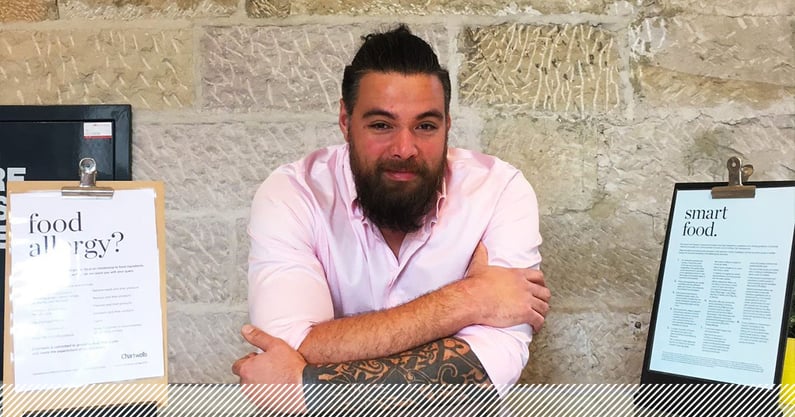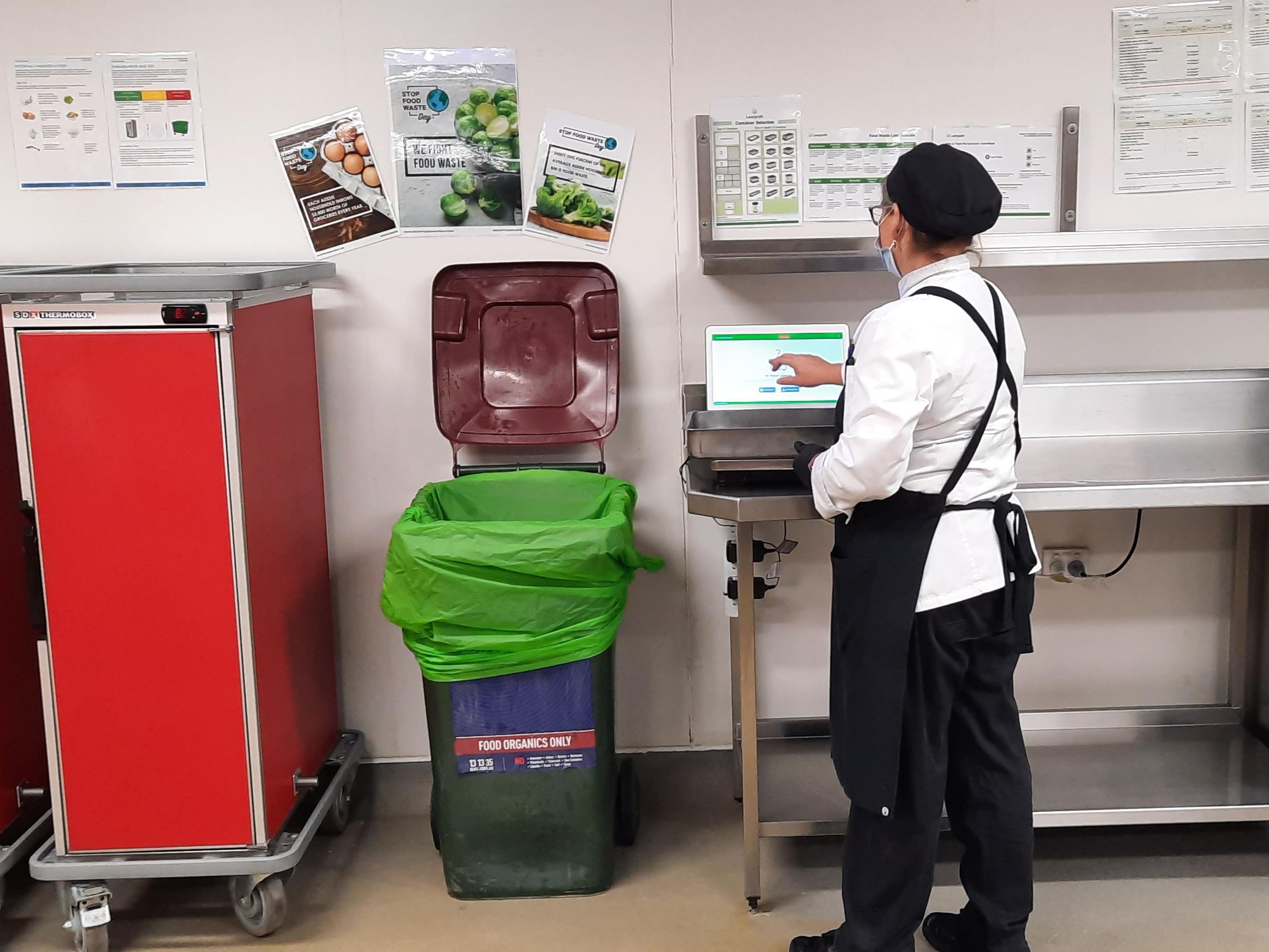Q&A with Compass Group Australia's National Food Waste Reduction Manager Winston Hugh

How do you provide great hospitality in some of the most inhospitable places on earth, without food waste costing the earth financially and environmentally? I asked Winston Hugh, Compass Group Australia’s National Food Waste Reduction Manager (what a great job title!).
An Exec Chef by background, Winston knows his apples when it comes to commercial kitchen operations. He’s also Canadian, so he’s no stranger to wide open spaces. Compass Group Australia’s Leanpath programme is overseen by him, and I was curious to find out what it’s really like to fight food waste in their Defence, Offshore and Remote (DOR) sites, which are often hundreds of miles from the nearest town. Think huge mining sites at the end of a long and dusty supply line with buffets for thousands of hungry miners, or barracks feeding servicemen and women on a large scale. Places where, to mis-quote AC/DC’s Angus Young, “It’s a Long Way to the Shop if you Wanna Sausage Roll.”
Q: What are the biggest challenges to reducing food waste in remote sites?
A: Lead times are definitely the biggest challenge from a planning, logistics and procurement perspective. We place food orders and forecast production two to three weeks in advance, so the ability to pivot quickly isn’t something you can rely on. All that has to be locked in place three weeks before it arrives at site regardless of your population. The site population or the “stay days," as we call them, come through from the client and if that number drops after our procurement operation is underway you are still buying the quantities and billing for the agreed amounts ordered. Traditionally, hospitality wastage is anything that’s thrown away which hasn’t had a sale dollar figure attached to it, and to shift that view you have to unravel waste behaviours at site from manager level right down to front-line staff, because commercially it’s all paid for by the client, so our costs are covered. Some might say, “Why worry if it’s all paid for?” but ethically, and from a customer value perspective, it means food waste. So we are using Leanpath to shift the conversation in our operations, especially in these inflationary times, to say reduction in food waste actually assists in your P&L.
Q: How remote are we talking here?
A: Some sites are so remote there’s a quarantine because the region’s ecosystem is so sensitive. I visited an offshore site where the food actually sits in quarantine for two days because the island that it’s on is a reserve and it’s easy to upset the biodiversity balance. When it’s this far to resupply, production teams worry about running out of food, because it takes four to five days to fulfil a food order even if we rush it. That leads to nervous energy in teams, which I think is largely unfounded: I’m constantly reassuring operators, chefs and procurement managers that we’re only targeting a reduction in the waste we’re producing, not a reduction in the food we are providing to our customer. That’s a big distinction to make: we’re not taking food off the customer’s plate, we’re taking food out of the bin, so it’s important how you convey the message to people. Bear in mind that it can be hard for remote teams, especially in newly mobilised sites and sites where they haven’t been since the beginning: they don’t want to miss their mark and get production levels wrong. Looking at it from the outside before I started visiting sites, food waste prevention seemed like such a simple problem but it’s like an onion: it’s got so many layers of overlapping problems that touch people in different ways. For example, how we structure our client contracts has bearing on this as well. That’s sometimes a difficult conversation; to eliminate surplus culture you have to take the customer with you on the journey, you have to take a look at how the Agreement and Scope of Works are structured. Discussion with your client how to put a great food offer out on the servery while generating less waste is a new kind of conversation. Many customers appreciate that discussion but some don’t. Sustainability is still quite a polarising topic here in Australia.
"We are using Leanpath to shift the conversation in our operations, especially in these inflationary times, to say reduction in food waste actually assists in your P&L."
Q: How has your Leanpath programme helped you have other new conversations?
A: We’ve had success in changing how we talk about food waste across the board. Sustainability can be a pretty polarising topic in offshore and remote sites, so going into those discussions with facts and data as opposed to feelings has been so helpful. I can’t tell you how valuable the Leanpath data is when you start to have those conversations. Also, we know it’s reliable, empiric data because it’s all collected via Leanpath trackers and can’t be inputted any other way. So when I get asked by my superiors, “Is this credible data?” my answer is always, “Yes, everything that is in the system is really happening on the ground.” It’s great being able to make statements like that, backed up by dependable data, and that helps to navigate those conversations. We can now talk about reducing waste and saving team time—and time is an especially valuable commodity at sites. A conversation about how producing food just to throw it away is an absolute waste of time really resonates with operators. Commercially, like everywhere else, there’s high food price inflation in Australia, so monitoring food P&L with Leanpath as a tool becomes a strong motivator. We can’t control inflation but being able to ride that wave with Leanpath as a solution has been really beneficial.
In terms of other conversations, we sometimes have a tough time reaching the populations of our remote sites, getting the message of sustainability across. For example in mining areas there’s a concern that a sustainability focus on reducing extractives will kill off their livelihoods. So we don’t run a plate waste reduction programme in those areas because of those concerns. But if we’re talking about reducing pre-consumer, or kitchen waste, then the costs of shipping food in and trucking waste away, and the positive impacts of reducing those, are good news stories—and not just for sharing internally; our clients are always interested in how we are doing in that area. In those sites where we do all the facilities management then the reduction in food waste disposal costs can be significant.
"Sustainability can be a pretty polarising topic in offshore and remote sites, so going into those discussions with facts and data as opposed to feelings has been so helpful."
Q: How are chefs responding to the Leanpath programme in these sites?
A: I’ll give you a Defence example, as our Defence customers are especially great. They are backed by the Australian government, which is very focused on sustainability, so client governance really spurs that on. Many of the chefs come from farming communities and they see the impacts of climate change; their communities are increasingly impacted by floods and bushfires so it’s an easy task to take them on the journey. Also many of the Defence personnel they are serving food to are employed when those natural disasters occur; they also need little persuasion of how important this is. So when we layer cost savings on top of that it’s really a no-brainer for them.
Also in the kitchen, team awareness has increased. Many of our team members are on a personal journey to permanent residency; they find the cost of living, healthcare and education is very expensive, and they hate waste!

Tracking food waste at a Compass remote site.
Q: Can you give me a practical example of how a chef has used their Leanpath data to make food waste reductions?
A: I was recently talking with David Blackmore, one of our exec chefs for an offshore client. He oversees 13 to 14 of our offshore sites which are all using Leanpath. David loves his data, so he’s a great guy to have these conversations with. Looking at our reporting, we could consistently see through the data that every day, every site was throwing away about a kilo and a half of baked beans at breakfast. Well, over two weeks that’s 300 kilos and a lot of money. Dave took that data immediately to his teams, showed them the graphs and trends and said, “Guys, a kilo and a half a day may not look like a lot to you, but here’s what it looks in aggregate and over time.” He set a goal across those sites to reduce baked bean waste and this week we’re seeing that waste come down. Dave’s now actively targeting the top three waste items by value on his Leanpath dashboard. He puts it out there in a weekly newsletter to the team: “We’re focusing on these three items this week,” and he sets a goal across all his sites to reduce waste on those items. So the teams tracking the waste really get that direct message, they can respond quickly to waste data and they love the positive feedback loop when the reduction goal is reached.
Waste data also enables us to ask good questions. Our top three food loss reasons in DOR are presented-not-sold, overproduction and expiry. This is principally driven by scope of contract, scope of menu and variety. Many sites are in competition with each other to secure talent so it’s all about village amenities, a great food offer with big and bright buffets. Those can be wasteful, but with their Leanpath data chefs can ask the right questions to reduce that, such as, “Do we really need seven types of sliced fruit on our buffet? Could we just rotate through three every other day and still provide a great offer to diners?” Those types of quick, high-impact decisions can now be made with clear data to back them up.
The teams are also using the printable food waste meeting agendas before each of the shifts to have a structured discussion on waste. They can make waste action plans for the shift and that brings a turnaround in discussions and culture within the teams, who get rewarded for their participation. So we are really changing hearts and minds about waste as well. The more that people engage with the Leanpath programme the more they can understand their food waste, and the more they can do about it.
Sign up for our monthly newsletter for the latest in
food waste prevention initiatives, best practices, webinars and more.